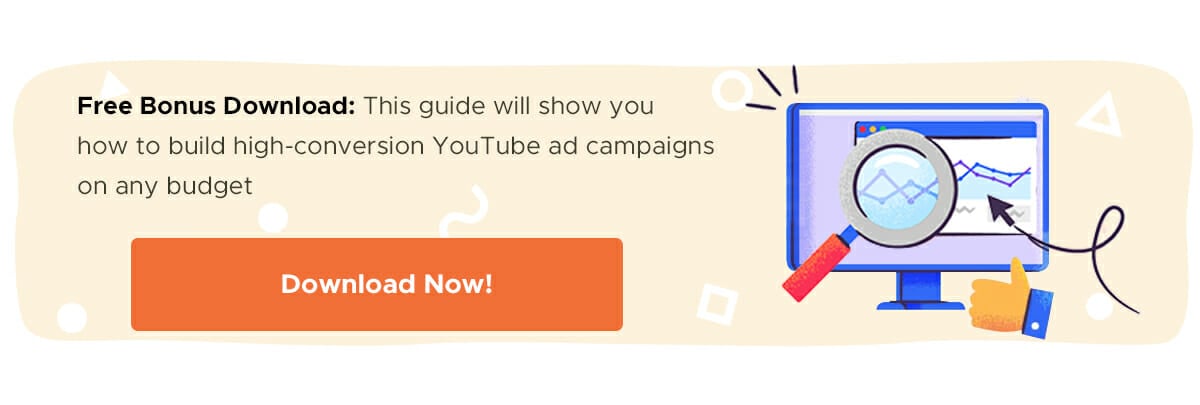Do you enjoy burning through your ad budget will little to show for it? Of course not.
But that’s exactly what you are doing if you are running Facebook ads with a low ad relevance score. As the Facebook advertising platform has matured, they’ve looked for ways to improve the quality of the advertisements that they show to their customers.
They’ve banned potentially misleading or predatory products and services like weight loss supplements and payday loans. They’ve continually refined their ad formats to find those that still perform while being less intrusive. And perhaps most importantly, they’ve instituted a “Relevance Score” program that seeks to measure the overall quality of each ad that they serve to their users.
If you’re familiar with Google Ads, you probably know all about their Google Ads Quality Score:
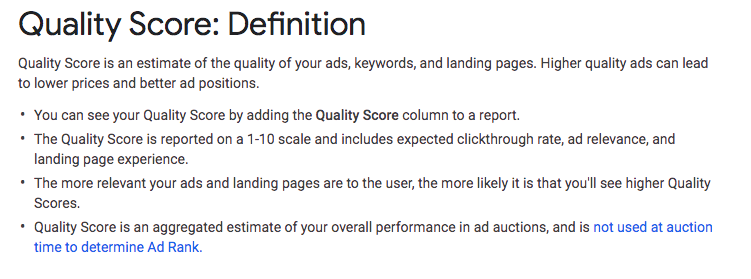
Like Facebook’s relevance score, Google’s system is designed to measure the relevance and quality of ads that they show to their users, providing a better experience in return. Facebook first introduced their relevance score in 2015 and have continued to refine it since then.
Now, let’s dive into exactly what the relevance score is, what the benefits of raising your ad’s relevance score are, and cover some simple tips that you can use to raise it.
What Is the Facebook Ads Relevance Score?
Facebook knows that serving ads that their users find annoying or non-relevant to them will hurt them over time. No one likes to continually be served ads for products and services that they have no interest in.
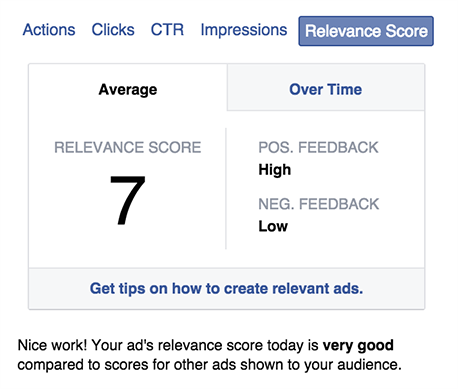
The relevance score for each of your ads is shown in your Ads Manager>Performance and Clicks screen. It looks like this:
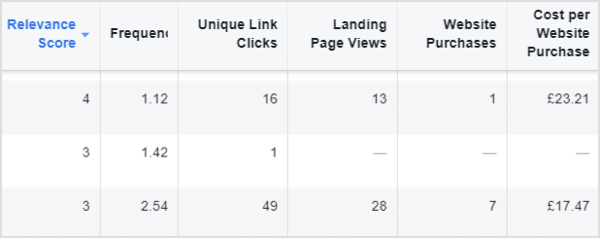
Every ad is scored from 1-10 and ads that receive a score of three or less are scored as less relevant. For ads with those scores to be shown, the company will have to bid a higher amount. Even so, ads with low relevance scores are never going to be displayed to the number of users that an ad with high relevance score would, so simply increasing your bid is not a good long-term strategy for growing impressions.
Here’s a breakdown of the scoring system:
- Relevance Score 1-3: Not relevant. Low impressions. Higher bids required.
- Relevance Score 4-7: Relevant. Solid impressions. Average bids.
- Relevance Score 8-10: Extremely relevant. High impressions. Lower bids.
The relevance score is a useful tool for Facebook to sift through their advertisers and display ads that connect with their users. The ads that get shown are the ones that have a combination of the highest bid and the most relevant ad.
This is a win-win for both Facebook and their audience: They get to display the ads that make them the most money (have the highest bid) and users get shown ads that they find useful and relevant to their interests.
Facebook defines their relevance score as:
“Your relevance score estimates how well your ad is resonating with the people you want to reach. The higher your ad’s relevance score, the better it’s considered to be performing.”
Dive Deeper:
How Does Facebook Determine Ad Relevance Score?
To improve the relevance score of your Facebook ads, you have to know which factors Facebook is using to produce the score.
There isn’t some Facebook intern sitting in their headquarters reviewing every ad and giving them a score. The relevance score is automatically generated. Facebook doesn’t publish the exact algorithm that they use to determine this number, but they do publish some of the factors that they use within it.
Like Google’s quality score, Facebook’s relevance score uses a number of different factors to determine an ad’s quality and relevance to its intended audience:
- Ad performance. Are people clicking on the ad? Are they watching the video? Are they installing the app? Do they scroll past the ad without viewing it? Facebook leans heavily on hard metrics in evaluating the relevance of ads. Ads that people interact with are generally going to be ads that are more relevant to their interests.
- Ad content. What kind of keywords are contained within the ad? How do those keywords align with your targeting choices? For example, showing an ad for baseball gloves to people who liked a page about cooking probably wouldn’t be super relevant to their interests.
- User feedback. Facebook also invites users to leave feedback on the ads that they have interacted with, and they can leave both positive and negative feedback. There are several ways to leave feedback on ads. In the image below, you can see the “Leave Feedback” dropdown. Facebook also includes an “I Don’t Want to See This” option next to ads in your timeline. If you receive too many negative reviews, your ad relevance score will drop.
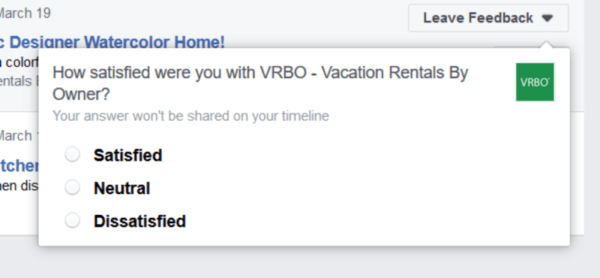
Tips for Improving Your Facebook Ads Relevance Score
A higher Facebook ad relevance score provides several benefits:
- Receive more impressions and reach a wider audience
- Lower bids for the same number of impressions
- Run A/B tests with a wider audience
- Improve campaigns by using relevance score to find target audiences
Now that we’ve defined what the Facebook ads relevance score is and how Facebook calculates it, let’s dive into some real-world tips that you can use to improve your relevance score and ensure that your ads are being shown to your target audience.
1) Know Your Audience
The most important step in creating highly relevant ads for any audience is knowing them well.
Facebook allows for deep targeting using demographic, usage data, saved audiences, custom audiences, etc. — there is no shortage of targeting options to ensure that you are targeting the right people.
Use buyer personas to craft compelling ads that speak to your audience’s biggest concerns, requirements and pain points. You can use your ad copy to overcome objections, address problems, ask questions, touch on preferences and call them to action in a way that will be compelling to your audience.
When you can effectively communicate in a way that resonates with your audience, your ads will naturally be more relevant to them.
Dive Deeper:
2) Target Deeper
Be more specific in who your ads target. Ensuring that each ad is laser-targeted toward a small sub-group of people is the most straightforward way to increase the relevance of your ads:
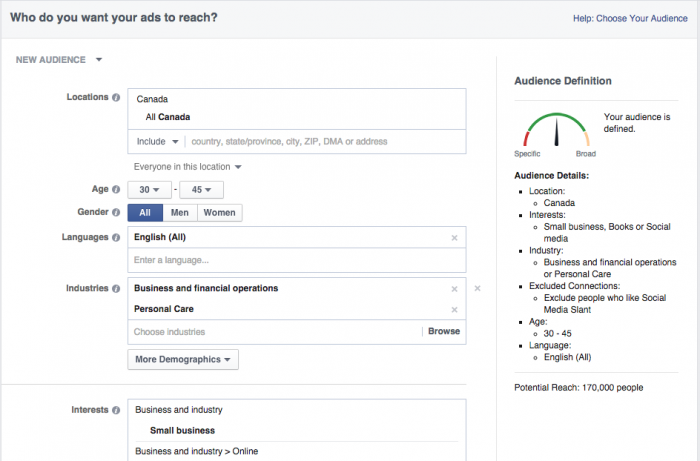
Facebook’s ad targeting options are substantial. You can reduce the audience of each ad by restricting the locations, targeting specific interests, targeting users that like specific pages or using retargeting options to speak to those who are already aware of your business.
Go smaller and more niche with each individual ad. In doing so, you’ll narrowly define your audience and can more easily craft compelling advertisements that speak to their audiences.
Additionally, you can use value-based lookalike audiences to laser-target your advertisements and increase relevance:
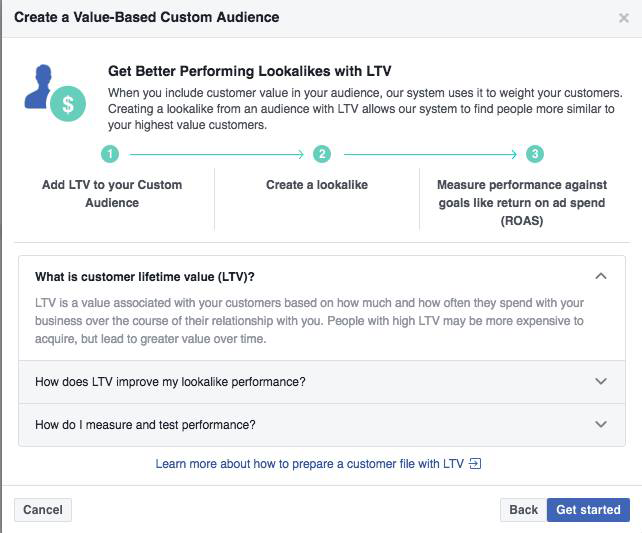
Source: KlientBoost
Value-based lookalike audiences contain users who are similar to your current customers. In theory, these users should convert at a higher rate than targeting audiences through traditional options.
3) Use Segmentation to Your Advantage
Segmentation is a powerful way to increase your relevance score. Advanced Facebook audience targeting allows you to dig deeper and show your ads to very specific subsets of a larger audience.
In an example, instead of showing your ads to a large saved audience that has a more general interest in your product, you could selectively show the ad to users who have previously engaged with similar content on the platform.
You can do this by creating a Facebook custom audience and including additional targeting criteria. You can create several segments of a larger custom audience and show each segment ads that speak to them specifically, resulting in higher relevance scores for each individual ad.
Dive Deeper: Segmentation 101: A Strategist’s Complete Guide to Marketing Segmentation
4) Show Ads to Those Who Have Engaged with Your Brand
Because engagement with your ad plays such a critical role in your relevance score, targeting those that have already engaged with your brand in some way can be a sure fire way to increase your score.
You could target Facebook users who have:
- Visited your Facebook page in the past
- Read content on your blog
- Liked some of your social media posts
- Clicked on an ad previously
- Visited your website
This is ideal because you know that these users are already aware of your brand. There is some initial trust built there that would not be present with someone who had never heard of your brand before.
Additionally, you know that those audiences are already willing to engage. With ad engagement playing such a large role in your relevance score, targeting users who have been proven to engage with your brand can give you a real leg-up over the competition.
5) Exclude Previously Converted Users
Someone who has already converted — purchased your product, signed up for your mailing list, whatever it may be — isn’t going to convert or engage a second time and therefore should not be shown your ads again.
Keeping already-converted users in your audience will only drag down your relevance score. Worse, they might not only avoid your ad, they might send negative feedback to Facebook by selecting “Hide Ad” for having been shown the ad again, dragging down your score further:
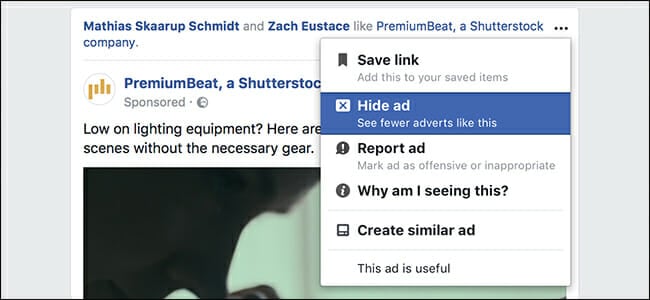
You can exclude previously converted users by clicking “Exclude” when you set up your custom audience targeting for your ad:
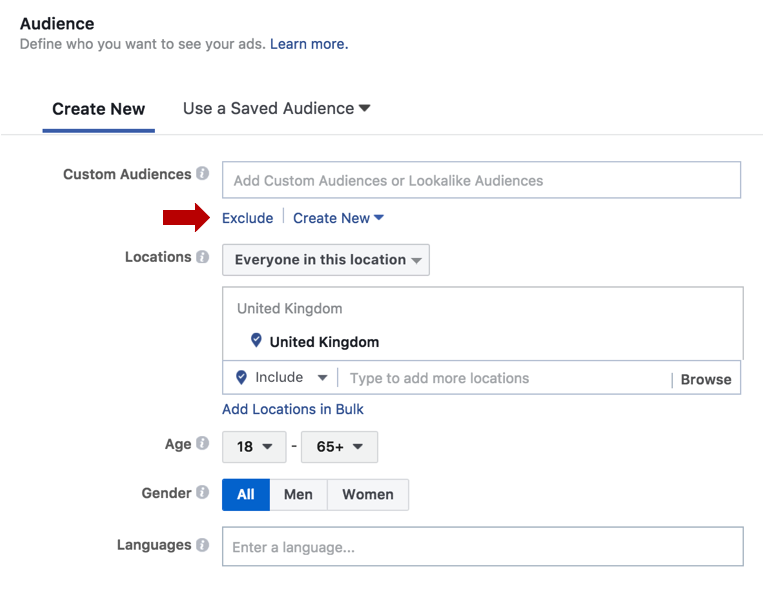
Dive Deeper:
6) Test and Optimize for Relevance Score
Most of the time when we A/B split test an ad, we are testing for conversions. It makes sense, because we want to optimize the ROAS for every ad that we run.
But if you are split testing and optimizing an ad with a low relevance score for conversions, you may actually be working backward.
Try testing and optimizing your ads for relevance score before you dig into conversion optimization. Once you reach a solid Facebook ad relevance score, then conversion optimization makes more sense.
Dive Deeper: How to Run A/B Tests that Actually Increase Conversions
7) Write Enticing Headlines to Drive Engagement
Headlines, headlines, headlines. Creating relevant and enticing headlines is perhaps the most important copywriting tip in all of marketing — and with good reason.
The success of any ad or marketing content depends so heavily on the headline. You can run the best ad in the world, but if your headline isn’t grabbing people’s attention then nobody is going to know because they won’t be drawn in enough to read the rest of the ad in the first place.
If your ad engagement is low, the first place to look is the headline.
Dive Deeper:
8) Include a Clear (and Valuable) Call-to-Action
Engagement plays a big role in the relevance score of any ad. Ultimately, audiences actively clicking through on your ad is perhaps the most important form of engagement that Facebook measures.
To encourage clicks, you have to call your audience to action. Tell them to click on it. Further — tell them why they should click.
“Click Here to Get Your Free Facebook Ads Strategy Guidebook”
Connect the call to action directly to your unique value proposition, and make sure that the next steps are clear: “If I do this, I get this.”
Dive Deeper: How to Create CTAs that Actually Cause Action
9) Create a Sense of Urgency
You want your audience to take action now, when they see the ad, not in a week when they are likely to have forgotten about your offer. According to the Wall Street Journal, the initial excitement that drives impulse buying usually subsides after about twenty minutes.
You need to get them to take action while that excitement in still intact. To facilitate this, you need to create some urgency and there are a few ways you can do this:
- Put a time limit on your offer — “Available today,” “Offer expires in 24 hours”
- Put a quantity limit on your offer — “Only 5 left!”
- Tie a discount to a time limit — “50% off when you order today”
- Make the urgency clear in your headline and image
The better you are at convincing your audience to take action immediately, the more engagement your ads will see.
10) Use Bright Images to Increase Visibility
Your images can play a critical role in how much attention your audience pays to your ad.
An attention-grabbing image can force people to stop scrolling and take notice when they see it. Brightly colored images stand out on the page and can increase the likelihood of this happening. Take this ad example from FreshBooks:
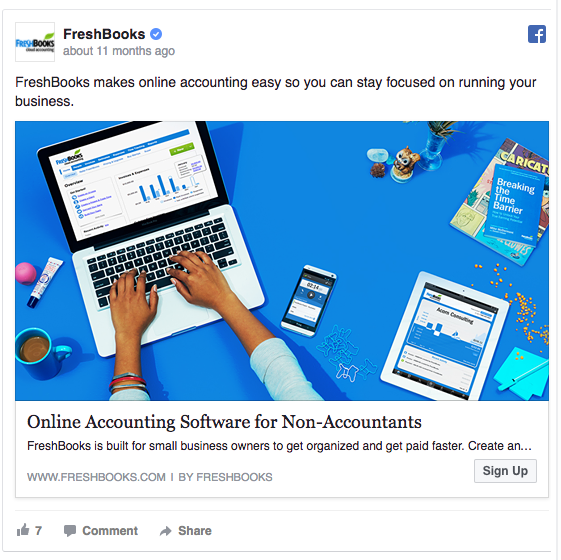
The bright blue color stands out against the pale blue color that Facebook uses in their user interface and can easily catch the eyes of your readers.
Dive Deeper:
11) Include Ad Copy in Your Image
Since ad images stand out, it makes sense that they should be used to their highest potential. Often, users will check out the image first before reading the rest of your ad copy. But that ad copy isn’t always that prominent.
Instead, you should test putting your main headline and other copy directly in the image, like AdEspresso did in this Facebook ad:
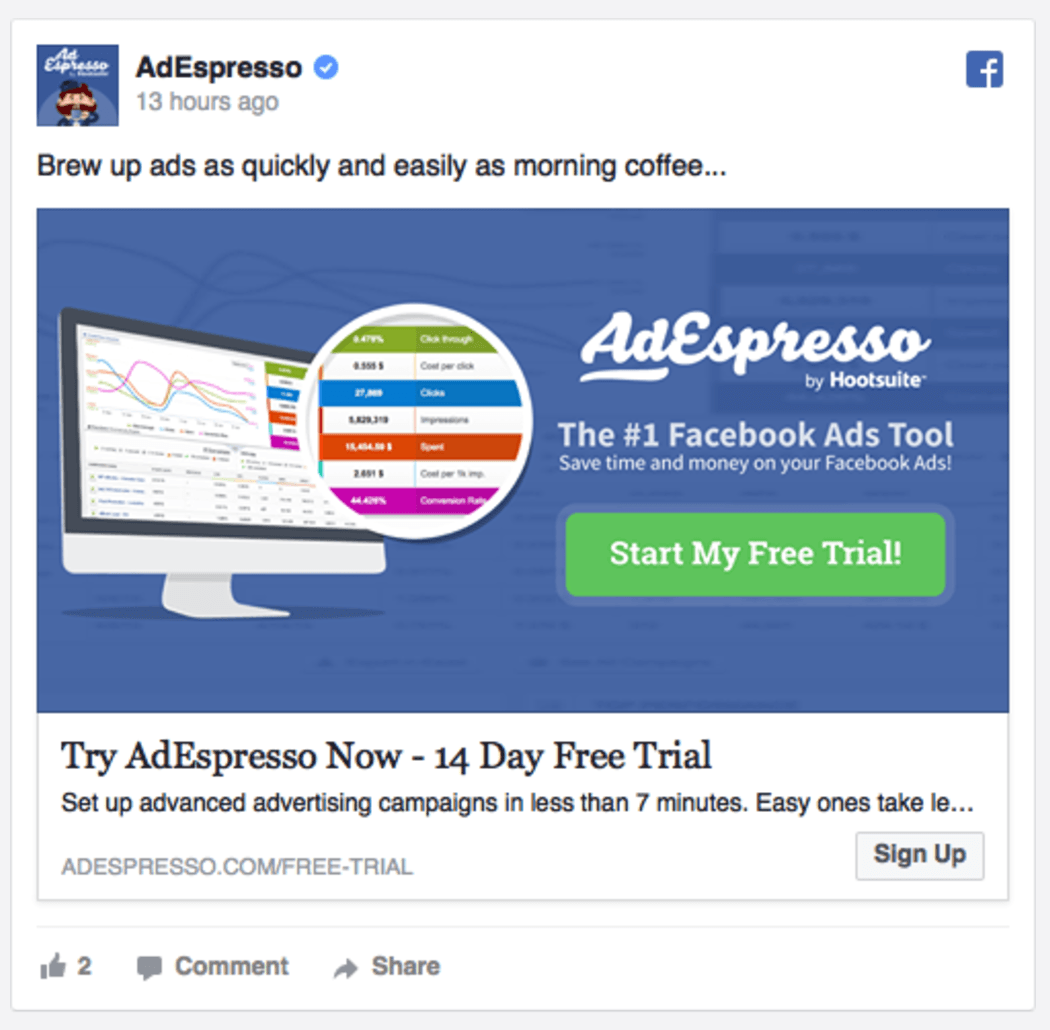
Not only does their image contain their main headline, but it also contains a sub-headline and call-to-action. The user has access to everything that they need to know without even reading the rest of the ad.
Engagement Signals Relevance
Facebook has honed in on one specific thing when it comes to their Facebook ads relevance score: engagement. They know that people engage with advertisements when they are relevant. When it speaks to them personally, they are more likely to click on the ad and give up their information.
In this article, we outlined eleven simple steps that any Facebook advertiser can take to increase the relevance score of all of their individual ads. Most of these tips focus on improving audience engagement. In following these tips, you’ll be able to increase the number of impressions your ads receive, reduce your bids and make it more difficult for the competition to displace you.
